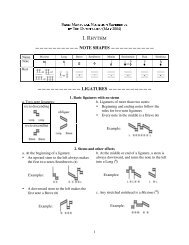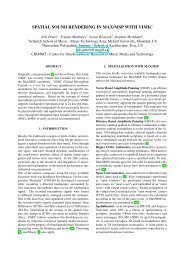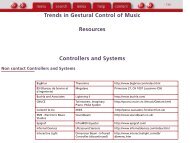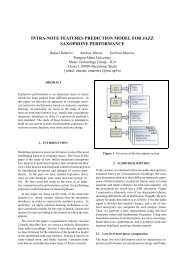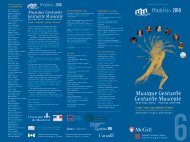Meaning in Musical Gesture
Meaning in Musical Gesture
Meaning in Musical Gesture
Create successful ePaper yourself
Turn your PDF publications into a flip-book with our unique Google optimized e-Paper software.
performance takes place (which he calls field control). Emmerson refers to local/field controls as two<br />
complementary systems that might be taken <strong>in</strong> the research agenda of musicians work<strong>in</strong>g with electronic<br />
systems. The balance between local and field controls could help <strong>in</strong> "reassembl<strong>in</strong>g some of the 'cause/effect'<br />
cha<strong>in</strong>s which have been broken by record<strong>in</strong>g and computer technology" (Emmerson, 1994: 31).<br />
Indeed, one of the most powerful features of an <strong>in</strong>teractive computer music system is the ability to<br />
constantly reorganize its configuration. While it opens a large spectrum of musical possibilities for sound<br />
production, it also avoids the constitution of stable connections between performance actions and results.<br />
The absence of a unique gestural mapp<strong>in</strong>g prevents the performer from deeply explor<strong>in</strong>g the system's<br />
controll<strong>in</strong>g mechanisms at the same time that it prevents the listener from connect<strong>in</strong>g visual <strong>in</strong>put and<br />
music. While the acousmatic effect <strong>in</strong> pure electroacoustic music tends to put the sound <strong>in</strong> evidence by<br />
break<strong>in</strong>g (or at least by weaken<strong>in</strong>g) its connection with its source, <strong>in</strong>teractive music renders this connection<br />
very unstable. As composer Dennis Smalley says:<br />
"[...] we can arrive at a situation where the sound<strong>in</strong>g spectro-morphologies do not correspond<br />
with perceived physical gesture: the listener is not adequately armed with a knowledge of the<br />
practicalities of new '<strong>in</strong>strumental' capabilities and limitations, and articulatory subtlety is not<br />
recognized and may even be reduced compared with the traditional <strong>in</strong>strument." (Smalley 1992:<br />
548)<br />
S<strong>in</strong>ce the 90's, <strong>in</strong>strument designers and musicians have to face the particularities of new electronic<br />
devices for music production <strong>in</strong> order to create effective <strong>in</strong>terfaces that would allow the expressive control<br />
of sound. Mapp<strong>in</strong>g gesture <strong>in</strong>to controll<strong>in</strong>g parameters is not a simple task. The manipulation of tape<br />
recorders, synthesizers, and computers elim<strong>in</strong>ates the materiality of sound. Differently from the sounds<br />
produced by mechanic <strong>in</strong>struments, electronic sounds do not embody any k<strong>in</strong>d of gestural relation to the<br />
devices that produce them. It represents a great autonomy and freedom <strong>in</strong> terms of compositional<br />
strategies, but at the same time it means a loss <strong>in</strong> the symbolic and mean<strong>in</strong>gful dimensions that can be<br />
present <strong>in</strong> a musical work. In the last 50 years electronic and digital technology expanded the possibilities<br />
for creat<strong>in</strong>g music <strong>in</strong> a very significant way, but this expansion also brought the risk of restrict<strong>in</strong>g the<br />
semiotic connections conceived dur<strong>in</strong>g the performance and listen<strong>in</strong>g. Today's musical activities based on<br />
the production of pre-recorded or electronic generated music have deviated from the embodied practice of<br />
performance to artificial processes of composition and diffusion. In these processes the loudspeaker<br />
replaces the performer, thus elim<strong>in</strong>at<strong>in</strong>g visual and gestural references that traditionally composed a<br />
significant dimension of musical language. In which way contemporary musical practices such as electronic<br />
<strong>in</strong>teractive music will restore this dimension is someth<strong>in</strong>g that still has to be elaborated and can be seen as<br />
a challenge that will enterta<strong>in</strong>, for some time, composers, performers and listeners alike.<br />
References<br />
Barfield, W., & Furners III, T. A., eds. 1995. Virtual Environment and Advanced Interface Design. Oxford:<br />
Oxford University Press.<br />
Barthes, R. 1977. "Musica Pratica." In Image - Music - Text. New York: Hill & Wang, pp. 149-154.<br />
Battier, M. 1992. "Sculpter la Transparence." Les Cahiers de L'Ircam - Recherche et Musique, 1, 57-75.<br />
Boethius, A. M. S. 1989) [c. 500]. Fundamentals of Music. Translated by Calv<strong>in</strong> M. Bower. New Haven &<br />
London: Yale University Press.<br />
Carr, K., and R. England, eds. 1995. Simulated and Virtual Realities: elements of perception. London:<br />
Taylor & Francis.<br />
Chabot, X. 1990. "<strong>Gesture</strong> Interfaces and a Software Toolkit for Performance with Electronics." Computer<br />
Music Journal, 14(2), 15-27.<br />
Chanan, M. 1994. Musica Practica: The Social Practice of Western Music from Gregorien Chant to<br />
Postmodernism. London, New York: Verso.<br />
Clynes, M. 1977. Sentics, the Touch of Emotions. New York: Anchor.<br />
Coker, W. 1972. Music & <strong>Mean<strong>in</strong>g</strong>: A Theoretical Introductions to <strong>Musical</strong> Aesthetics. New York: The Free<br />
Press.<br />
Repr<strong>in</strong>t from : Trends <strong>in</strong> Gestural Control of Music, M.M. Wanderley and M. Battier, eds.<br />
© 2000, Ircam Centre Pompidou 266




